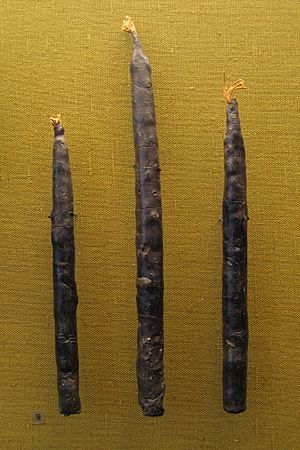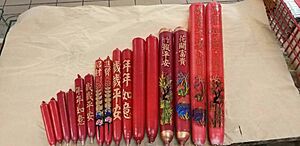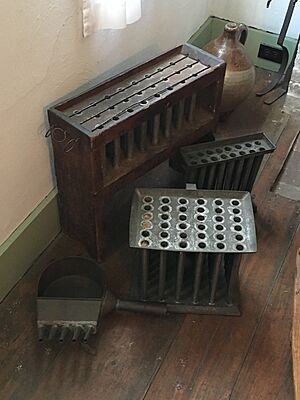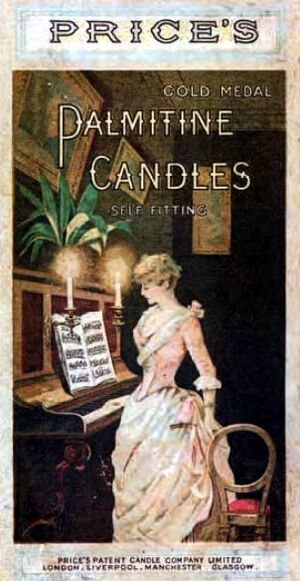History of candle making facts for kids

Candle making is the art of creating candles. It was invented in different parts of the world at different times. For a long time, candles were the main way people lit up their homes at night.
In Europe, candles were mostly made from animal fat called tallow and beeswax for many centuries. Later, people started using spermaceti from sperm whales in the 1700s and 1800s. After that, purified animal fats (stearin) and paraffin wax became popular in the 1800s. In China, some old writings suggest candles were made from whale fat a long time ago. Chinese candles could also be made from beeswax, plant waxes like stillingia tallow, or even insect wax. In Japan, people used Japan wax from a special tree. In India, wax from boiling cinnamon was used for temple candles.
Early candle makers in Europe used different methods. They would dip a wick into melted wax or fat many times. They also shaped soft wax around a wick by hand or poured wax over it. Later, they started using moulds. In the 1800s, factories began making huge amounts of candles. Even though electric lights are common now, candles are still made and used for many reasons.
Contents
Ancient Candles: Lighting Up the Past
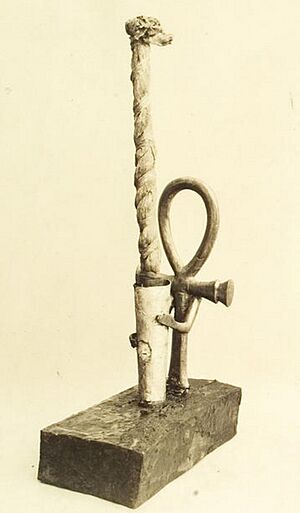
Before candles, ancient people used open fires, torches, and lamps to see in the dark. Simple oil lamps, where a lit wick sat in oil or fat, were used even in the Stone Age. We don't know exactly when or where candles were first used. Some objects found in ancient Babylonia, the Minoan civilization, and the tomb of Tutankhamun might have been candle holders. There's even a possible picture of a lit candle in an ancient Egyptian tomb.
Early candles probably looked different from today's candles. They were likely made from plant materials dipped in animal fat. The Ancient Greeks offered moon-shaped honey cakes with small torches or candles to their moon goddess Artemis. Some people think this is how the tradition of putting candles on birthday cakes started! However, birthday cakes like we know them today only appeared around 1600 in Europe.
Candles in Ancient Rome

Many believe that candles with wicks first appeared in Italy during the Etruscan civilization. A picture of a candlestick was found in an Etruscan tomb, and the oldest Etruscan candlestick might be from the 7th century BC. Candles might have grown from simple wicks made of plant fibers soaked in fat or oil.
The Romans made real dipped candles from tallow (animal fat) and beeswax. Beeswax candles were very expensive, so only rich people could afford them. Oil lamps were more common in Roman Italy, but candles were still used often. They were even given as gifts during the Roman festival of Saturnalia.
Candles in Early Churches

In Christian churches, candles became very important for decoration, meaning, and special events. Wax candles were used as early as the 3rd century. The Christian festival Candlemas was even named after candles. Popes made rules that only beeswax, not tallow, should be used for candles on the main altar.
Beeswax was collected after honey was taken from beehives. It was cleaned by boiling it in seawater. Early candles were made by dipping a wick into melted fat or wax many times until it was the right size. People also rolled soft wax around a wick by hand or poured wax over it. Using moulds to make candles became popular in the 1300s.
Candles in Ancient China
In China, the tomb of Qin Shi Huang, the first emperor (259–210 BC), was said to have candles made from whale fat. The Chinese word for "candle" was used during the Warring States period (403–221 BCE). Some old bronze items from that time have a spike that might have held a candle.
A Chinese dictionary from about 40 BC suggests that candles were made of beeswax. Later, a book from 648 AD clearly mentions beeswax candles being used by a statesman. An old pot from the 4th century AD was found with traces of wax inside.
Candlefish in America
There's a fish called the eulachon or "candlefish" found from Oregon to Alaska. Native Americans in this area used oil from this fish for light. They could make a simple candle by putting the dried fish on a stick and lighting it.
Candles in the Middle Ages
After the Roman Empire fell, it became hard to get olive oil, which was used in lamps. So, candles became much more common across Europe.
Candles were everywhere in Europe during the Middle Ages. Candle makers, called chandlers, made candles from leftover kitchen fats or sold their own. They were also sometimes called "smeremongere" because they made other things like sauces and soap. Candles were so popular that they were used in festivals like Candlemas and Saint Lucy's Day.
Tallow (fat from cows or sheep) became the main material for candles in Europe. Tallow candles had a bad smell because of something called glycerine. The smell of making them was so strong that some cities banned it! Beeswax candles didn't smell bad and were much better, but they were very expensive. So, only rich people, churches, and royal events used them.
Candle Making Guilds
In England and France, candle making became a special craft by the 1200s. A French guild was recorded as early as 1061. The Tallow Chandlers Company in London was formed around 1300. The Wax Chandlers Company existed even earlier. By 1415, tallow candles were used to light streets. The first candle mould appeared in Paris in the 1400s. However, candles often stuck to the moulds and broke. Making candles efficiently with moulds only really improved in the 1800s.
Candles in the Middle East and Asia
In the Middle East, during the Abbasid and Fatimid empires, beeswax was the main material for candles. Beeswax was often brought from far away, like from Tunis to Egypt. Like in Europe, these candles were quite expensive. Most ordinary people used oil lamps. But rich people spent a lot of money on candles. For example, one caliph spent a huge amount of silver on candles for his palaces every year.
In early Syria, everyone wanted candles for marriage ceremonies. There were candle makers' guilds in the city of Isfahan in the 1500s and 1600s. However, candle makers in Iran had a lower social standing, similar to barbers or porters.
In China, beeswax candles were common during the Tang and Sung dynasties. Wax from the Chinese tallow tree could be used with beeswax. This plant wax melts easily, so it was often covered with harder beeswax. The Chinese started growing the tallow tree in the 600s. Its wax was often used for Buddhist candles. Another type of wax, called Chinese wax, came from insects and was very good quality. The Chinese learned to make this wax by the Yuan dynasty. Some Chinese candles had a bamboo stick in the middle. Paper was wrapped around it with a rush wick, and then it was dipped in melted wax many times. These candles could be colored and decorated with symbols.
The Japanese made candles in similar ways to the Chinese. They also developed a method of moulding candles using paper tubes. They used Japan wax from the Japanese wax tree.
In India, wax from boiling cinnamon was used for temple candles. In Tibet, yak butter was used for candles.
Modern Candle Making
In the 1700s, the whaling industry grew, and spermaceti became widely used for candles. Spermaceti is an oil from the head of a sperm whale. This wax was made by crystallizing the oil. It was the first candle material available in large amounts. Like beeswax, spermaceti wax didn't smell bad when burned and gave off a much brighter light. It was also harder than tallow or beeswax, so it wouldn't bend in summer heat. The first "standard candles" were made from spermaceti wax.
By 1800, an even cheaper option was found. Colza oil and rapeseed oil made candles that burned clearly without smoke. In 1825, French chemists patented stearin. This was also from animals, but it didn't have glycerine, so it didn't smell bad.
Candle Factories and New Materials
Candle making became a big factory industry in the mid-1800s. In 1834, Joseph Morgan from England invented a machine that changed everything. It could make moulded candles continuously. A cylinder with a moving part pushed out candles as they hardened. This machine could make about 1,500 candles an hour! This meant that even poorer people could now easily afford candles.
Around this time, candle makers also started making wicks from tightly braided cotton. These wicks would curl over as they burned, keeping the flame at a good height. Because much of the extra wick burned away, they were called "self-trimming" wicks.
In 1848, James Young set up the first oil refinery in England. He made two paraffin wax candles from natural paraffin found in oil. In the 1850s, James Young learned how to get paraffin wax from coal and oil shales. This made it possible to produce paraffin wax in large amounts.
Paraffin could be used to make cheap, high-quality candles. It was a bluish-white wax that burned cleanly and didn't smell bad, unlike tallow candles. One problem was that early paraffin waxes melted very easily. But then, the invention of stearin solved this. Stearin is hard and strong, and it melts at a good temperature. By the end of the 1800s, most candles were made from a mix of paraffin and stearic acid.
By the late 1800s, Price's Candles in London was the biggest candle maker in the world. The company started in 1829, trying to make candles from coconut oil and later palm oil. But then, the founder's son, George Wilson, discovered how to distill petroleum oil in 1854. He also used steam to make candles from many different materials, like animal fats and industrial greases.
In America, Syracuse, New York became a major center for candle making in the mid-1800s.
Candles Today
Even with all these improvements, the candle industry quickly became less important when better lighting methods appeared. These included kerosene lamps and, from 1879, the incandescent light bulb (the electric light bulb).
From then on, candles were sold more as decorative items. They still have special meanings, like being used for wishes or in religious ceremonies. Today, candles come in many sizes, shapes, and colors. Scented candles also became very popular. In the 1990s, new types of candle waxes were made because people wanted so many candles. Paraffin, which comes from oil, became more expensive.
Candle makers started looking at waxes like soy, palm, and flax-seed oil. They often mixed these with paraffin to get the good qualities of paraffin but at a lower cost. These new wax mixes needed different kinds of wicks and fragrances. This pushed wick makers to invent new ways to make wicks that worked well with these new candle formulas.
Gallery
See also
 In Spanish: Historia de la fabricación de velas para niños
In Spanish: Historia de la fabricación de velas para niños


